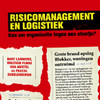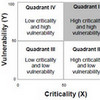 Two weeks ago I attended the ISCRiM 2010 seminar at Loughborough University, a gathering of some of the finest researchers in supply chain risk. Here I had the chance to meet and talk to the people I so far have only blogged about, and it was a very inspiring two days in Loughborough. In order to disseminate the research that was presented at the seminar to a wider audience I have decided to publish the proceedings on my blog so that other researchers, academics and practioners can keep abreast of the latest in supply chain risk research.
Two weeks ago I attended the ISCRiM 2010 seminar at Loughborough University, a gathering of some of the finest researchers in supply chain risk. Here I had the chance to meet and talk to the people I so far have only blogged about, and it was a very inspiring two days in Loughborough. In order to disseminate the research that was presented at the seminar to a wider audience I have decided to publish the proceedings on my blog so that other researchers, academics and practioners can keep abreast of the latest in supply chain risk research.
ISCRiM
The ISCRiM is a network of academics and researchers interested in how to handle different types of risks in the supply chain. The main purpose of the ISCRiM-network is to speed up, and improve, the research within “Supply Chain Risk Management”. Founded in 2001, it has now grown to include 36 members in more than 20 countries. ISCRiM holds annual research seminars, open to members and invited speakers only, and publishes newsletters 2-3 times per year, highlighting the latest research findings, journal articles, books, PhD theses and other tidbits of interest to the supply chain risk research community.
My muse has returned
During summer, this blog saw a marked decline in blog postings, let alone quality blog postings. With my visit to ISCRiM that downturn is definitely over, as I here found renewed inspiration to keep on blogging about supply chain risk and disseminating my reviews of the latest research in this field. Meeting so many of my blogging subjects will is also likely to enhance my future reviews, as I feel a closer relationship to the articles I read, now that I now know many of the persons behind my reviews. I envision that it will probably also lead to a streamlining of my blog posts towards topics of a more academic nature, i.e. a stronger focus on literature reviews and research news.
ISCRiM 2010 Proceedings
The ISCRiM Proceedings, available for download below, along with their presentations, contain 16 papers on a variety of subjects, divided intro three sections. Some is published, some about to be published, some are PhD theses still in progress. Not all papers were presented, though, and some of the research presented at the seminar is not in the proceedings.
Section 1: Supply Chain Risk Management theories
Supply Chain Risk Management: Where are we? by Bob Ritchie and Clare Brindley, in essence, is a review of the presentations given at the first major international seminar on SCRM, held in Barcelona in 2009…and mentioned on my blog here.
What is Supply Chain Risk Management in the perception of researchers? by Manmohan S. Sodhi, Byung-Gak Son, and Christopher S. Tang takes a closer look at three “gaps” pertinent to future research in SCRM: (1) no clear consensus on the definition of SCRM; (2) lack of commensurate research on response to supply chain risk incidents; and (3) a shortage of empirical research in the area of SCRM.
When do Supply Chain Disruptions become the norm? Insights from Normal Accident and High Reliability theories by Christoph Bode and Stephan M. Wagner is based on an empirical study using normal accident theory; it indicates that supply chain complexity, in fact, increases the frequency of supply chain disruption.
Supply Chain Risk & Returns Management (SCR2M) by Barbara Gaudenzi and Ivan Russo explores how risk management can support the effective and efficient movement of products backwards in a supply chain, due to, say, consumers’ returns, marketing returns, asset returns, product recalls and environmental returns.
The Influence of Cognitive Biases on Managerial Perceptions of Supply Chain Risk by Maja Puljić adresses the behavioural perspective of supply chain risk research, an hitherto underresearched area within SCRM.
Section 2: Supply Chain Risk Management Frameworks
Scenario Planning in Supply Chain Risk Management by Aman Deep and Samir Dani studies the risks and uncertainties surrounding global food supply chains, and discusses the feasibility of using scenario planning to address food supply chain risks.
A Methodology for Identifying, Categorising and Prioritising sources of Supply Chain Vulnerability by Yang Chu and Brian Squire introduces a comprehensive and rigorous methodology for systematically identifying, categorising and prioritising risks within supply chains, thus enabling efficient resource allocation for the mitigation and monitoring of supply chain risks.
Supply Risk Management: moving towards a Quantitative approach by Fabiana Pirola, Roberto Pinto and George Zsidisin lays the foundation for the development of an optimization model for better understanding supply risk and the how the implementation of redundancy and flexibility practices can provide firms greater resilience in their supply chains.
Assessing Supplier Default Risk on the Portfolio Level: a Method and Application by Stephan M. Wagner and Christoph Bode is based on a an empirical study that show how adding more suppliers is not necessarily adding more redundancy. A published version of this paper has been reviewed on my blog.
Supply Chains Risks: a Systems Thinking Perspective by Abhijeet Ghadge and Samir Dani takes a systems perspective towards managing supply chain risks. It presents variables that may affect next generation supply chains and applies a causal loop model towards depicting the causal linkages of these variables with future supply disruptions.
Integrating Supply Chain Risks in Product Development: a Conceptual Framework by Josef Oehmen, Mohamed Den-Daya and Omera Khan develops a conceptual framework for integrating supply chain risks in product development, in which they identify the supply chain risks that originate in the five different stages of the generic product development process.
Section 3: Supply Chain Risk Management- Sectoral View
Supply Chain Risk: Commonalities and Differences between Italy and Switzerland/Germany by Gandolf R. Finke, Roberto Pinto, Fabiana Pirola, and Bruce Arntzen presents some of the main results of a global survey about experiences and attitudes toward supply chain risks and risk management in companies based in different countries.
Supply Chain Disruptions in Sparse Transportation Networks – a Norwegian Perspective by Jan Husdal investigates how companies located in sparse road networks are affected by and relate to supply chain disruptions and how Norwegian freight carriers handle transportation disruptions. My full paper can be read here.
Drivers of Security in Distribution Networks– a Survey of Swedish Transportation Companies by Luca Urciuoli looks specifically at the factors influence the insecurity of distribution networks from a freight carrier’s point of view and establishes a comprehensive framework that identifies all contributing stakeholders, actors and perpetrators.
The Impact of Supply Chain Risk on Regional Economies by Michael E. Smith examines the intersection of geography and economics as a way to provide a framework for understanding supply chain risk and serves to encourage broad collaboration, including public-private partnerships to mediate the sources of large-scale or regional supply chain disruption.
Exchange Rate Risk in the Fashion Accessory Sector: a Case Study by Patrick Brown, Omera Khan contains a brief literature review, synthesised with company-specific data analysis, with an aim to identify appropriate actions that can be taken to mitigate supply chain risk associated with exchange rate fluctuations.
Future reviews
While each of the papers presented in the proceedings is more than worthy of a separate review on this blog, the short summary above will have to suffice. However, as I discover or am made aware of published past or future papers relating to the above, I will of course review these on my blog.
Reference
Proceedings of the 10th International Research Seminar on Supply Chain Risk Management, ISCRiM, edited by Samir Dani, Sep 6-7, Loughborough, UK. ISBN: 978-1-907382-31-4-
Related posts
- husdal.com: ISCRIM Newsletters












